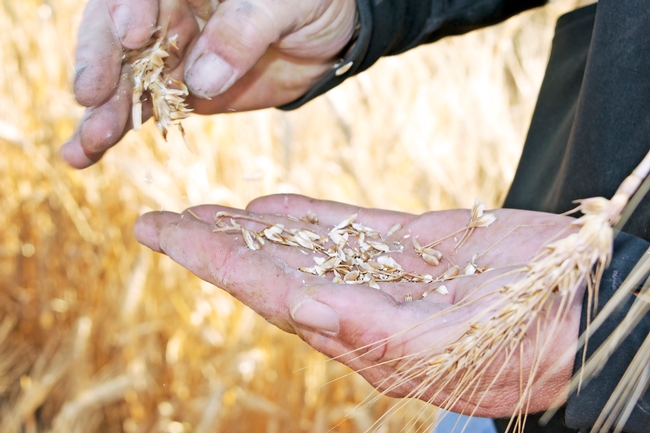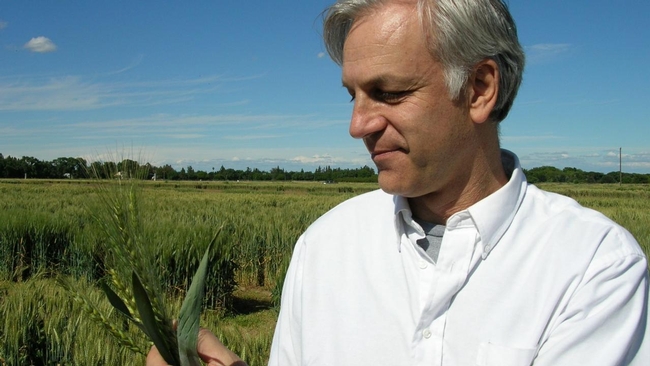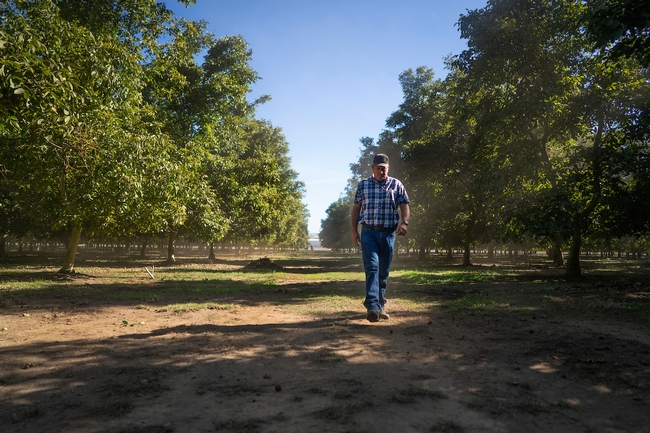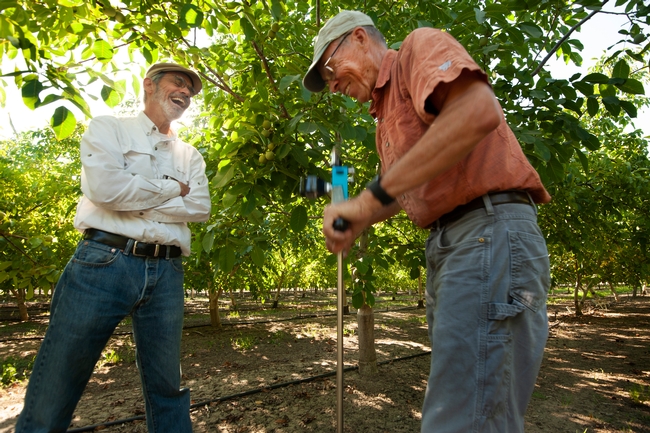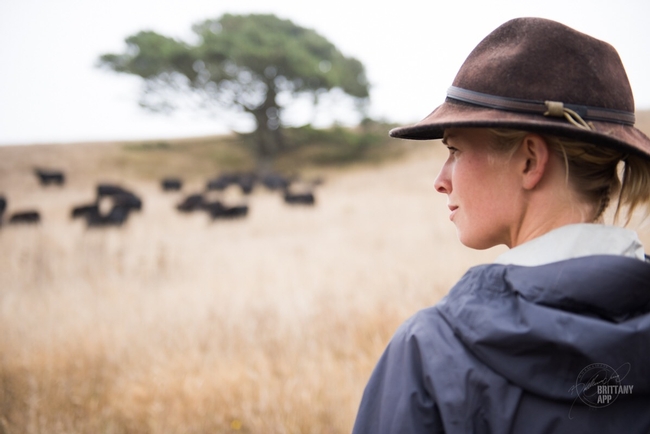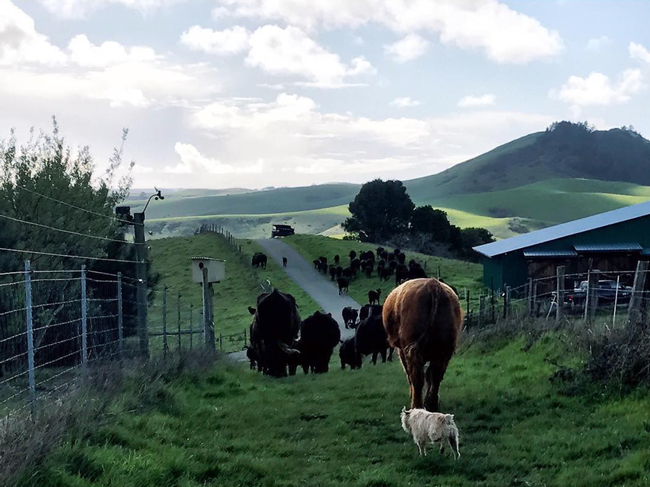Posts Tagged: College of Agricultural and Environmental Sciences
Should there be more microbes on your plate?
Scientists make the first large-scale estimate of live microorganisms consumed in the U.S. diet
Our diets provide us with the building blocks we need to stay healthy and fight disease. The nutrients in foods and beverages can be tallied up to know if we are getting what our bodies need. Yet what if a nutrient has been overlooked? For instance, friendly microbes in raw and fermented foods have not been measured as part of our diets — until now.
“Ultimately we want to understand if there should be a recommended daily intake of these microbes to keep us healthy, either through the foods or from probiotic supplements,” said Maria Marco, a professor in the food science and technology department at UC Davis. “In order to do that, we need to first quantify the number of live microorganisms we consume today in our diets.”
Marco co-authored a new study with a group of scientists that examined the number of living microbes per gram of more than 9,000 different foods consumed by nearly 75,000 adults and children. It found that around 20% of children and 26% of adults consumed foods with high levels of live microorganisms in their diet. Both children and adults increased their consumption of these foods over the 18-year study period. The study, published in the Journal of Nutrition, is the first large-scale estimate of how many live microbes are consumed by Americans every day.
“This trend is going in the right direction. Exposure to friendly microorganisms in our foods can be good for promoting a healthy immune system.” said Marco.
Foods for gut health
Study authors examined the National Health and Nutrition Examination Survey to create the estimate. The health and dietary database contains extensive information on the foods consumed by Americans daily. Food science and fermentation experts assigned each food an estimated range of live microbes per gram, creating categories of foods with low, medium and high levels of live microbes. Foods in the high category included fermented dairy foods such as yogurt, fermented pickles and kimchi. Fresh, uncooked fruits and vegetables were also good sources of live microorganisms, represented in the medium category.
The analysis was funded by a grant from the International Scientific Association for Probiotics and Prebiotics, or ISAPP. The microorganisms quantified in this study are not necessarily probiotics.
“By definition, a probiotic must be well-defined and have a demonstrated health benefit at a quantified dose. Live microbes associated with food as a category, however, do not generally meet the criteria of a probiotic,” said corresponding author Mary Ellen Sanders, executive science officer for the ISAPP.
The publication is part of a larger global effort to determine how live dietary microbes might contribute to health.
“There is no doubt that the microbes we eat affect our health. When we think of microbes in our food, we often think of either foodborne pathogens that cause disease or probiotics that provide a documented health benefit,” said co-author Colin Hill, a professor of microbial food safety with University College Cork, Ireland. “But it's important to also explore dietary microbes that we consume in fermented and uncooked foods. It is very timely to estimate the daily intake of microbes by individuals in modern society as a first step towards a scientific evaluation of the importance of dietary microbes in human health and well-being.”
Other scientists co-authoring the paper were ISAPP board members Robert Hutkins, Dan Merenstein, Daniel J. Tancredi, Christopher J. Cifelli, Jaime Gahche, Joanne L. Slavin and Victor L. Fulgoni III.
Editor's note: Maria Marco is affiliated with UC Agriculture and Natural Resources as an Agricultural Experiment Station faculty member.
Can vines speed urban cooling?
Study explores cooling benefits of fast-growing vines as trees take their time
Perhaps trees aren't the only green solution when it comes to cooling urban spaces and reducing energy costs. Honeysuckle, Virginia creeper, pink trumpet and other vines could be a fast-growing substitute in climate-smart cities of the future.
Researchers from UC Davis are leading a nearly $880,000 federal grant to study how vines may provide cooling and shade in Western states in less time than it takes a tree to grow tall.
“Vines can quickly shade buildings and reduce energy consumption while trees slowly grow to maturity,” said Alessandro Ossola, an assistant professor of plant sciences who is a principal investigator for the project. “We believe vines can be an effective and cheap measure to help cities accelerating climate change adaptation.”
The grant from the U.S. Department of Agriculture's Agricultural Marketing Service will fund work to plant and monitor at least 10 types of vines on trellises in five locations in different climate zones over three years. California Department of Food and Agriculture is administering the grant.
Using less water
Water conservation will be vital as populations rise, climate extremes become more prevalent and the demand for agricultural and drinking water increases. The goal of this research is to identify vines that can help save energy by providing cooling and reduce the need for irrigated water.
“In addition to rapid growth rates, vines can be easily integrated with structures to maximize potential cooling effects,” said Loren Oki, a Cooperative Extension specialist with Department of Plant Sciences, who is the project lead. “But we need to understand the relationships between low water-use plants and their ability to reduce thermal loads on buildings.”
The vines will be planted, supported by a trellis and watered regularly during the first growing season to establish deep roots and healthy shoots. Over the next two years, the vines will experience low, moderate and high water allocations.
The vines will be rated on aesthetics, foliage quality, floral quantity, pest and disease resistance, appearance and other factors. Thermal images of trellis coverage and other environmental measurements will also be taken to assess shading and cooling potential, according to grant documents.
Many vines can be grown along cables and wire nets that are actually detached from walls to avoid direct contact and still provide shade, Ossola said.
“We want to understand which vine characteristics relate to fast growth, reduced water use and increased aesthetic appeal,” he added.
Outreach and education
The findings will enable recommendations to be developed for regions, planners, the landscape industry and the public. It could lead to plants being designated as “water-wise,” “low-water use,” “energy-saving” or “cooling.”
Extensive engagement and outreach will also publicize the information.
“Climate change is a great opportunity for the horticultural industry to innovate and promote climate-ready plant productions,” Ossola said.
USDA funding supports research across state lines to find innovative solutions to regional and national problems, USDA Under Secretary for Marketing and Regulatory Programs Jenny Lester Moffitt said in a news release announcing this and other grants.
“This year's funded projects will address a range of those challenges, from energy and water saving in vine plants, finding cost-effective solutions for heat tolerance and drought, to addressing food safety risks for produce,” Moffitt said.
Scientists from the University of Arizona, University of Washington, Utah State University and the South Coast Research and Extension Center at UC Agricultural and Natural Resources are contributing to the research and will be overseeing vine sites in their states.
This article is reprinted from the UC Davis College of Agricultural and Environmental (CA&ES) website, where it is titled "Could Vines Be the Answers to Speeding Urban Cooling, Water Reduction in the West?"
UC Davis team identifies wheat gene that increases yield
The findings could help growers produce more wheat without expanding operation
A team of scientists from University of California, Davis, have identified a new gene variant in wheat that can increase the amount of the grain produced, new research published in the journal PLOS Genetics finds.
Wheat is a staple of food diets worldwide and the gene discovery could allow farmers to grow more food without increasing land use. Increased yield could also lower consumer prices, making the crop more accessible.
“We have a growing human population that likes to eat every day,” said Jorge Dubcovsky, a plant sciences distinguished professor who led the research. “We need to produce more wheat in the same space so we need plants that are more productive.”
The researchers found a gene – WAPO1 – that controls the maximum number of grains in a wheat spike. Breeding the beneficial gene variant into the plants could delay the formation of the terminal spikelet, providing room for more grains to grow in each spike rather than ending production of grain.
WAPO1 is one of the first genes discovered that can affect wheat yield. “We are trying to make more productive wheat varieties and we are starting to understand how that trait is controlled,” Dubcovsky said.
Pasta wheat lacking the gene
The gene variant for high grain number is found frequently in bread wheats but not in pasta wheats. By breeding the beneficial gene variant into those pasta wheat varieties, growers could increase yield by 4% to 5% in cultivars that have the biomass capacity to fill the extra grains.
“We developed molecular markers to select for the form of that gene to produce increased yield,” Dubcovsky said. “It's a significant step forward.”
Previous research by the team mapped the gene and identified others that could affect yield. This research confirmed those findings for WAPO1.
Discovery on path to future yield increases
The WAPO1 gene is part of a network of genes that work together to control yield, and researchers need to identify the best variant combinations to maximize yield. Solving this puzzle can lead to better production rates.
“We will continue to try to understand the network of genes that control the yield of wheat,” he said.
Saarah Kuzay, Huiqiong Lin, Chengxia Li, Shisheng Chen, Daniel P. Woods and Junli Zhang from UC Davis also contributed to the research, as did scientists from Howard Hughes Medical Institute, Heinrich Heine University and Peking University Institute of Advanced Agricultural Sciences.
Funding was provided by USDAs National Institute of Food and Agriculture's Food Research Initiative, the International Wheat Yield Partnership and Howard Hughes Medical Institute.
A nutty idea: A little stress could be good for walnuts
When it comes to watering walnuts, most California growers believe you need to start early to keep trees healthy and productive throughout the long, hot summer. But according to striking results from a long-term experiment in a walnut orchard in Red Bluff, growers can improve crop production if they hold off irrigation until later in the season and directly measure their trees' water needs.
The findings from researchers at the University of California may help farmers optimize water use.
“It's a game-changer,” said walnut grower Hal Crain, who welcomed researchers on to his orchard to test irrigation optimization. “It's clear to me you can improve nut quality and yield by applying water based on what the tree wants and needs, rather than just watering when it's hot outside and the soil is dry. That's a big deal for walnut growers and for the entire agricultural industry.”
Changing the paradigm
Crain is a second-generation farmer whose family has been growing walnuts in Butte and Tehama counties for 55 years. Like most walnut farmers, Crain had always started irrigating in early to mid-May when the days grew warmer and the trees sprouted leaves.
“That's standard practice for probably 90 percent of California's walnut growers,” said Crain, walking amid his trees on a sunny afternoon. “The theory is that when you irrigate early, you preserve the deep moisture in the soil that trees need to survive the heat of summer.”
But that's not how it works, the research shows. Instead, trees that grow in saturated soil early in the season don't develop the deep roots they need to thrive.
“With all the water right there at the surface, the lower roots suffer,” explained Bruce Lampinen, UC Cooperative Extension orchard management specialist with the UC Davis Department of Plant Sciences. “Trees end up with a very shallow root system, which doesn't serve them well as they try to extract moisture from the soil later on.”
Lampinen has long suspected that walnuts were getting too much water in the spring.
“A lot of the symptoms we see like yellowing leaves and various diseases can all be explained by overwatering,” said Lampinen.
So Lampinen did what scientists do: He set up an experiment. Five years ago, with funding from the California Walnut Board and the U.S. Department of Agriculture, he joined forces with Ken Shackel, a plant sciences professor with UC Davis, and Allan Fulton, an irrigation adviser with UC Cooperative Extension. Together, they led a team of scientists testing irrigation on Crain's ranch.
“Hal is an exceptional partner,” Fulton said. “Farmers have a lot to accommodate when they host an experiment like this, with researchers going in and out of the orchard at all hours. He had to work around our people and the timing of our water treatments. He's always eager to experiment with technology and learn new things, and he shares what he learns with other growers. Hal completes the circle.”
Tough nut to crack
When is the best time to irrigate? Researchers say the trees hold the answer. Scientists use pressure chambers, which are air-pressure devices that measure a leaf or small shoot to gauge how hard the plant is working to pull moisture from the soil.
“Just because the soil looks dry doesn't mean the plant is suffering,” said Shackel, who specializes in plant physiology. “Pressure chambers let you ask the tree how it's feeling — sort of like taking a human's blood pressure — which is a much more accurate way to measure a plant's water needs.”
For the last five years, the team has been applying different water treatments to five blocks of trees. One block is getting standard, early irrigation. Crain's orchard managers begin irrigating the other blocks when the trees reach different levels of water stress based on pressure-chamber readings.
The trees that experience moderate stress are doing the best. Their irrigation usually starts in mid-to-late June, several weeks later than when standard watering begins.
“You can tell just by looking at that block that the trees are healthier,” said Crain, standing beneath a canopy of lush, green trees. “And, we're starting to see greater yields and better nut quality.”
Translating the research
The research is helping scientists advise farmers on irrigation.
“My biggest take-away is knowing when to start watering is a really important factor to the health of your trees,” Lampinen says.
Pressure chambers — sometimes called pressure bombs — can cost more than $3,000, and high-tech versions are under development.
“I tell growers a pressure bomb would pay for itself even if you just used it once a year to determine when to start watering,” Lampinen said.
Crain is certainly convinced.
“When you irrigate based on your trees' needs, you optimize water,” Crain says. “I'm not using less water overall, but the water I do use is producing more food. That's good news for everyone.”
This story was originally published in the Fall 2018 issue of Outlook Magazine, the alumni magazine for the UC Davis College of Agricultural and Environmental Sciences.
Change on the range
“When first-generation ranchers succeed, we all succeed,” says Kate Munden-Dixon, a Ph.D. student working with Leslie Roche, Cooperative Extension rangeland specialist with the UC Division of Agriculture and Natural Resources and the UC Davis Department of Plant Sciences.
Munden-Dixon and Roche recently discovered that many new livestock managers aren't plugged into information networks such as UC Cooperative Extension and rancher coalitions that provide science and strategies for making sustainable rangeland management decisions. This lack of connection can make first-generation ranchers more vulnerable when dealing with challenges like drought and climate variability, according to their study, which was recently published in Rangeland Journal.
To help bridge the gap, Munden-Dixon landed a $25,000 Graduate Student Grant from Western Sustainable Agriculture Research and Education, a USDA program, to reach out to new ranchers and rangeland managers.
Why rangelands matter
More than one half of California — 38 million acres — is rangeland that provides open space, healthy watersheds, carbon storage, food, fiber and habitat for diverse plants and wildlife. UC Davis research indicates grasslands and rangeland have become more resilient at sequestering or consuming carbon dioxide pollution than forests in California, making them especially important in a warming world.
But rangeland and livestock production are at risk because more rangeland is being converted to housing and crop production. The average age of ranchers in California is 62, and fewer children are taking over the family ranch.
Enter a new wave of rangeland managers. Many of these young ranchers don't yet have access to the capital required to purchase land and large head of cattle and other livestock. Instead, they often contract with public and private landowners to graze goats, sheep and cattle to restore landscapes and reduce fire vegetation.
“What we really need is support in connecting land and contract opportunities,” says Brittany Cole Bush, an “urban shepherdess” and former contract sheep and goat grazer. She now consults with land owners and public agencies from her home base in Southern California. “We need market research that shows the value that grazing brings to fire abatement, soil conservation and so much more. Market research would increase our value and help us become viable players.”
Expanding Extension
Munden-Dixon is interviewing 40 new rangeland managers from across California to explore how decision-making by different demographics influences adaptation to climate change and quality of life. Munden-Dixon and her team are also hosting workshops to make sure Cooperative Extension specialists understand and can respond to all ranchers' needs.
“There is both a need and opportunity for a new generation of livestock managers that is able to adapt to California's changing climate,” Munden-Dixon says. “This next generation may not look like your typical rancher, so we want to ensure organizations are helping all ranchers succeed, regardless of their demographics or land tenure.”
The power of connection
Munden-Dixon would like to become a Cooperative Extension specialist herself one day. Working with first-generation ranchers reminds her that collaboration and public engagement are critical to addressing issues in sustainable agriculture.
“There is no one answer or single expert when it comes to building healthy food systems,” Munden-Dixon says. “We find solutions when we work together.”
See this story in the Fall/Winter 2018 issue of Outlook, a magazine from the UC Davis College of Agricultural and Environmental Sciences, and at the UC Davis Science & Climate website.




